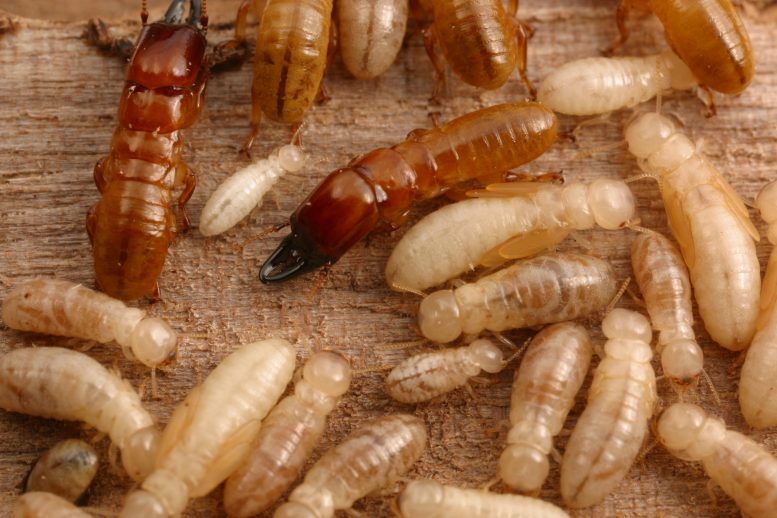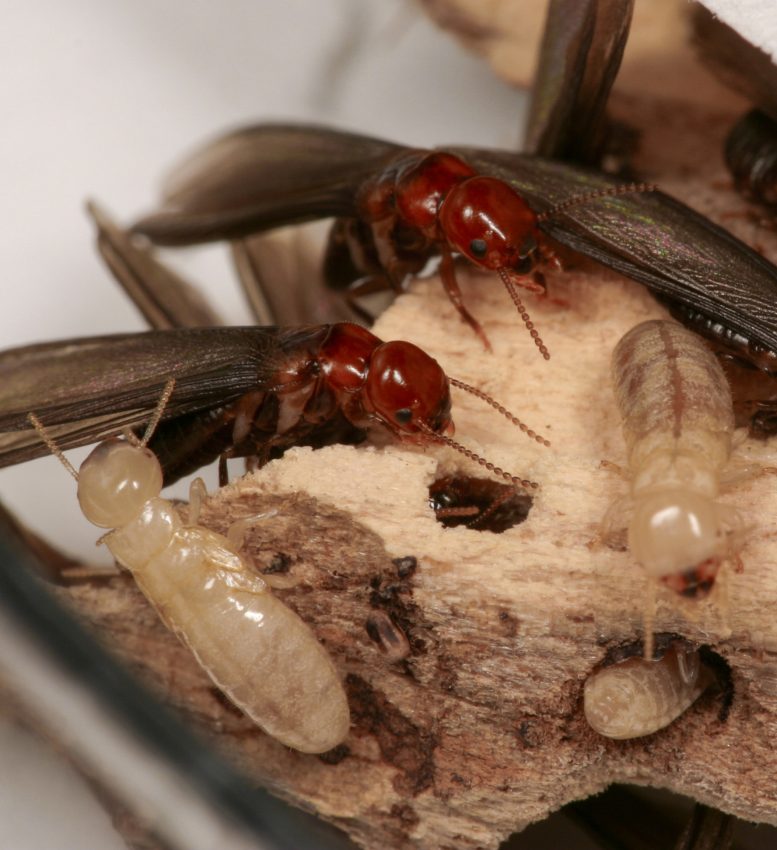
UC Riverside scientists discovered a new termite control method using pinene to attract termites to insecticide, offering a non-toxic, cost-effective alternative to traditional fumigation. Credit: Dong-Hwan Choe/UCR
UC Riverside scientists have introduced an effective and sustainable termite control strategy using pinene to lure termites into insecticide-treated areas, achieving over 95% effectiveness and reducing the reliance on harmful fumigation methods.
UC Riverside scientists have discovered a highly effective, nontoxic, and less expensive way to lure hungry termites to their doom.
The method, detailed in the Journal of Economic Entomology, uses a pleasant-smelling chemical released by forest trees called pinene that reminds western drywood termites of their food. They follow the scent to a spot of insecticide injected into wood.
“We saw significant differences in the death rates using insecticide alone versus the insecticide plus pinene,” said UCR entomologist Dong-Hwan Choe, who led the discovery. “Without pinene, we got about 70% mortality. When we added it in, it was over 95%.
Native to North America, western drywood termites are environmentally important. They are drawn to dead wood above ground, and consume it with the help of microorganisms in their guts. “They are recyclers,” Choe said. “And they’re very common.”
Current Challenges in Termite Control
Unfortunately for humans, the insects are unable to distinguish between dead trees and the wood used to build homes. Of particular concern in California and Florida, as well as parts of Canada and Mexico, no dwelling is immune to them. “It’s only a matter of time before termites attack a house, especially in warmer parts of the states,” Choe said.
Fumigation is one of the most common drywood termite control techniques. Homes are covered with tents and then bombed with gas that kills the insects. In the U.S., California uses this method more than any other state.

Western drywood termites are attracted to pinene, a chemical found released by forest trees. Credit: Dong-Hwan Choe/UCR
The pest control industry is under pressure to find new methods because the chemical, sulfuryl fluoride, is both a greenhouse gas and is also toxic to humans. Additionally, fumigation is an expensive process that does not provide lasting protection against termites.
“Even though it is very thorough, a home can be infested again soon after fumigation is completed,” Choe said. “Some people fumigate every three to five years because it doesn’t protect structures from future infestations.”
Advantages of Localized Injection and Use of Pinene
Localized injection is an alternative strategy to control drywood termites that does not involve gas. Technicians drill holes into the infested wood to reach the termite “gallery” or lair, then inject poison into the hole to inundate the bugs.
“This is a more localized treatment, and in theory, it is a better strategy when you want to control drywood termites with fewer chemicals. It’s less expensive, and the treated wood may also stay protected from future infestations,” Choe said.
The challenge with localized injection is figuring out exactly where the bugs are hiding. Typically, this method uses a contact-based insecticide, meaning the insects must touch the poison for it to work.
Using an attractant like pinene eliminates the need to hunt for the termites. “Even at low concentrations, pinene is good at attracting termites from a distance,” Choe said.
“We don’t think it’s functioning as a pheromone,” Choe said. “We think the scent is more associated with their food. Smells nice… dinner time! That’s the concept that we had in mind.”
The insecticide they used, fipronil, is also used to control ant infestations. It can be toxic to aquatic insects and pollinators if it gets into the environment. In this case, it is injected into the wood, so chances of off-target effects are low.
Choe’s laboratory generally studies the chemical communication systems of urban insect pests to develop strategies like this one for western drywood termites.
“Our study shows that if you understand insect behavior better, it’s interesting by itself,” Choe said. “Then there are also important implications for more effective pest management, so we can use fewer chemicals without compromising efficiency.”
Reference: “Potential use of pinenes to improve localized insecticide injections targeting the western drywood termite (Blattodea: Kalotermitidae)” by Nicholas A Poulos, Chow-Yang Lee, Michael K Rust and Dong-Hwan Choe, 16 May 2024, Journal of Economic Entomology.
DOI: 10.1093/jee/toae101









So how many decades until this becomes a commercial product?
Would pinene be effective against other species of termites other than the western dry wood kind here in North America? Our home in the Philippines has been reinfested multiple times and l’m afraid that soon, the whole structure will just crumble. This is so, despite many years of treating them with an insecticide in the past..
The termites are all over, even getting into our personal belongings like clothing, footwear, books, papers, etc. And as the previous reader had commented, when will this wonderful anti-termite treatment be available in the market? I could volunteer our home to the scientific team to use in their clinical study if it will work against the Asian species.
Can it be a parasite problem for humans? Someone that’s never had skin problems ( not even much acne in teenage years. So went from almost perfect skin at 30 years old to having these big lessions ( painful ) they would come up and take weeks to heal, then scar. Lost like 70 bs mostly in my waist. Not trying. My hair thined out…. could it be this?? I was told by a doc that u can’t get parasites in the United States… that’s the most stupid thing I’ve ever heard. Anything is possible.
The article is misleading by implying no pesticide, but Fipronil (an insecticide) is used in the study.
Pinene serves as an attractant, luring the Termites to areas treated by Fipronil and thus to their demise.
Nice study but I doubt it’s practicality.
You need to do a better job of informing your readers.
Hi,I live in Puerto Rico,and the termites her are a real pest.will it be possible to get the pinene and the pesticide here .I would love to use it,so I can get rid of the intrusive termites.
Noviflumuron is the active ingredient that kills off termite colonies in leading termiticide barriers these days.
A simple way to keep termites away is by placing pieces of unused wood in the corners of the yard 5 to 6 meters from the house
Replace the wood if it has been eaten by termites.
That’s it everyone happy
Hi I live in Jamaica and termites is a HUGE problem it eats everything, from furniture to cabinets to floorboards, it’s such a nuance…it’s so hard to control and you cannot cover the house to exterminate..where can I find Pinene to try
Natutal spring water is what I’d use it kills termites so put natural spring water on your termite.issies and man it’s a huge